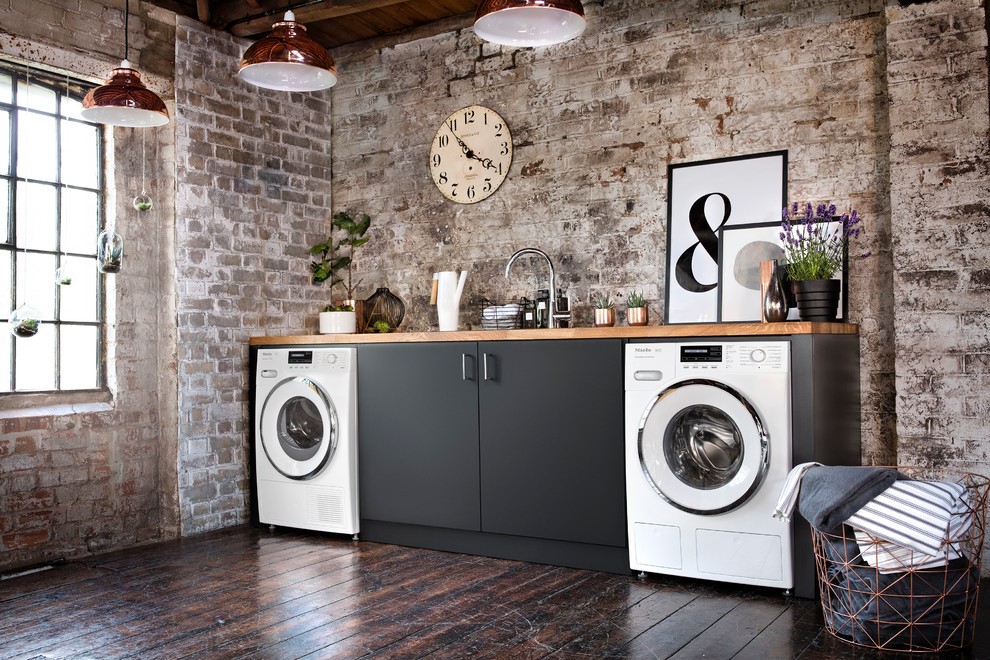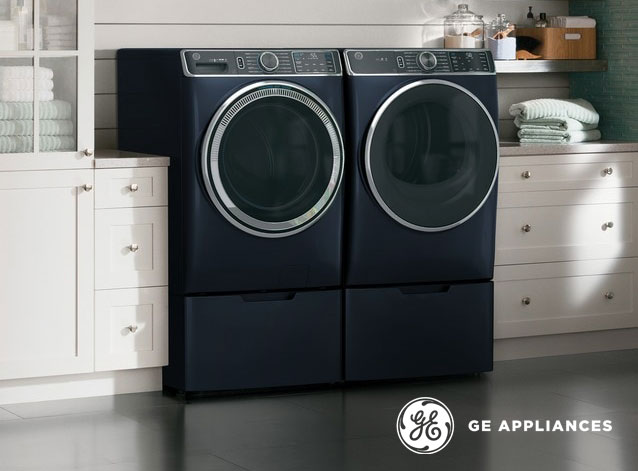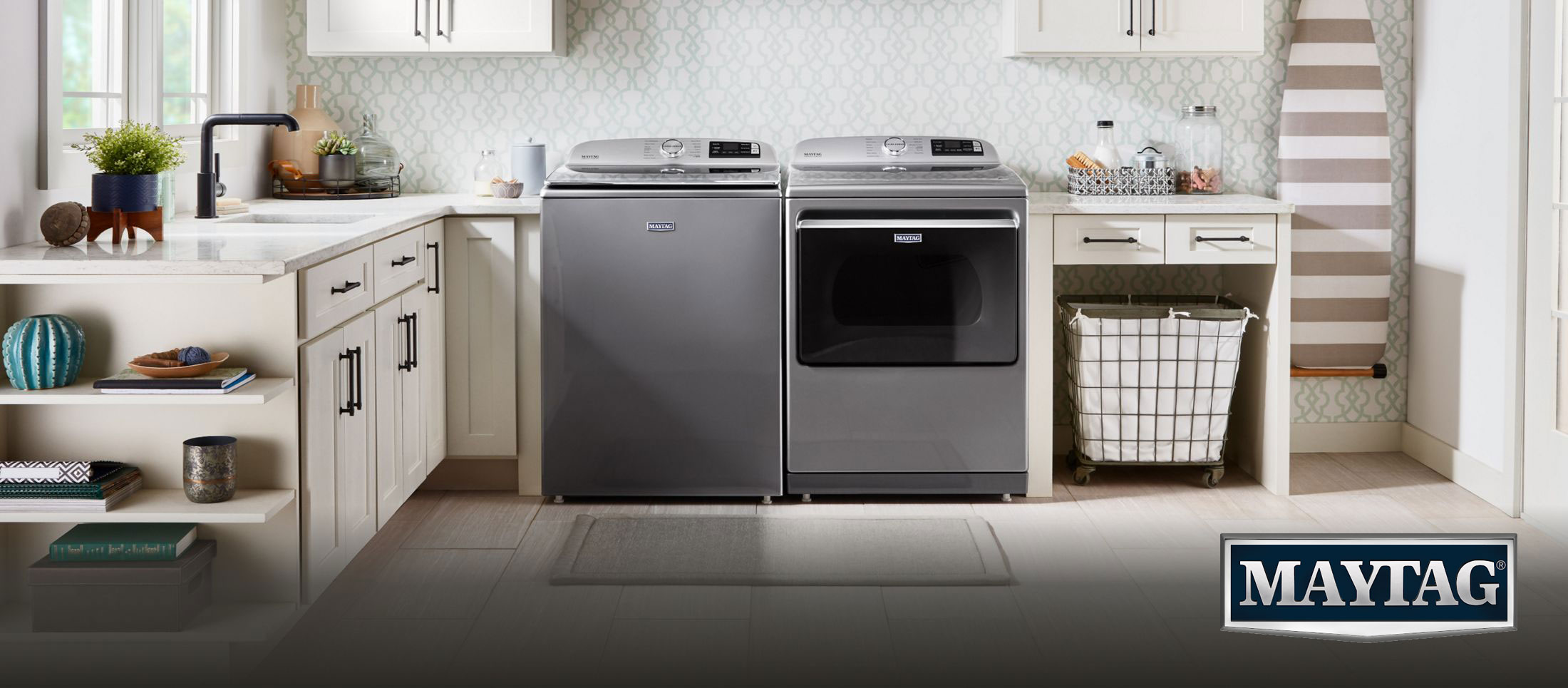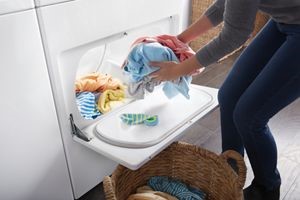If you’ve been following our blog series on how to buy a washer and dryer, you might be caught up on our previous blog for three things to do before you shop for a washer or dryer. This time around, we’re taking you to the next level with a laundry appliance size guide that helps you better understand which washer or dryer is best suited for your home.
Knowing how to properly measure the dimensions of your home for a new washer or dryer is important for various reasons. For one, establishing a perfect fit the first time helps you avoid the hassle and cost of returning your new laundry appliance. Secondly, a washer or dryer that works organically in your laundry space will provide a more satisfying user experience.
By the end of this in-depth comparison, you’ll be able to confidently assess whether the new washer or dryer you’ve had your eye on is a match made in appliance heaven.
Note: All measurements referenced in this blog are based off currently available products.
For easier evaluation, we’ve also rounded up measurements to the nearest whole number. While not exactly the official measurement, this makes the process easier to follow and accounts for any inconsistencies a space may have.
- E.g., 23.75in width → 24in
For the most accurate dimensions, always refer to the product Spec Sheets (located below the product description).
General Tips
Consider these the five commandments of laundry appliance measuring. While each brand features different measurements for specifics, these general considerations apply to most washers and dryers.
1. Make space for venting
- Standard dryer vents are four inches in diameter and should not exceed 25 feet in length; generally, this requires 4 inches of clearance in the back, and will therefore add four inches to the overall depth
2. Beware tight fits
- Especially when installing a washer or dryer into a closet space
- Tight fits make it hard to perform regular maintenance and to install properly
3. Keep an eye on clearance
- Depending on the brand and model, a washer or dryer can use a door that swings open, up, out, or down
- Make sure there are not obstructions and always consider the “Depth/Height with Door Open” specification
4. Inspect for backside obstructions
- A common offender of impaired installation is a gas pipeline which inhibits a gas dryer from fully sitting into a space
- Washer water lines can also be an impediment, especially if the hot water and cold-water valves are not located in a recessed wall space
5. Consider alternatives
- With professional help, dryers can often be adapted to vent from the side or the back to allow a better installation
- Front-load laundry pairs can often be stacked with a simple stacking accessory
- For extra-tight spaces, consider ventless washers and dryers that save you six inches of clearance in the back
Front-Load Washers and Dryers
In terms of size, front-load washers and dryers are available in the most diverse selection compared to their standard washers and dryers. Front-load laundry appliances can be grouped into three categories: compact washers and dryers; full-size washers and dryers; and mega-capacity washers and dryers, explained in the following table.
| General Dimensions of Front-Load Washers and Dryers |
|
|
|
|---|---|---|---|
| Width | 24 inches | 27 inches | 28-30 inches |
| Height | 34 inches | 39 inches | 40-42 inches |
| Depth (door closed) | 24 inches* | 32-34 inches* | 32-34 inches* |
| Depth (door open) | 42-44 inches* | 54-57 inches* | 55-56 inches* |
*Not including standard 4-inch venting
Compact Washers and Dryers
Compact washers and dryers the perfect solution for lofts, apartments, in-law suites, or anywhere a standard-size washer or dryer will not fit. These can be further divided into two options, vented and ventless compact washers and dryers.
Vented, compact washer and dryer units typically measure 24in x 34in x 24in (WxHxD), not including an additional four inches for venting and connections. With doors open to a full 90 degrees, this category generally falls between 42 inches and 44 inches in depth compared to the 50-inch average from standard washers and dryers. Check out this ultra-compact Asko front-load washer that uses just 40 inches with the door fully open!
Ventless dryers are another space-friendly option, especially in situations that do not allow installation of a vent. These dryers work by collecting moisture into a reservoir, which can later be emptied down a drain. By eliminating the need for a vent, a ventless dryer saves 4 inches from the overall depth, which can be the difference from fitting into a closet or not.

To fully enjoy the space-saving advantage of a compact washer or dryer, we recommend brands like Asko, Bosch, or Miele, which carry dryers that slip into spaces as small as 26 inches deep, and that’s including the vent.
Shop compact washers
Shop compact dryers
Full-Size Washers and Dryers
Considered the industry standard, full-size washers and dryers are generally 27 inches in width, making them an easy substitute for top-load units. Full-size washers and dryers typically measure 27in x 39in and 32in to 34in deep (WxHxD), not including an additional four inches for venting and connections. With doors open to a full 90 degrees, this category generally falls between 54 inches to 57 inches in depth.
While you top-loading, full-size washers are available, the most common configuration is a front-loading washer and dryer. This not only creates a more consistent user experience, but it also allows for the units to be stacked.
Since front-loading laundry appliances require you to reach into the unit, depth makes all the difference. Some full-size, front-loading units facilitate this by designing shallow drums. Select LG laundry pairs offers the shallowest depth, some even measuring 34 inches in depth, including ventilation.

Shop Full-Size Washers
Shop Full-Size Dryers
Mega-Capacity Washers and Dryers
These are the Goliaths of washers and dryers, designed to tackle the largest loads with frequency. Sounds like a win-win, but at a minimum of 28 inches in width, this category of washers and dryers requires careful measurement to ensure they fit in your home. Additionally, the market for these washers and dryers remains relatively small (we currently carry six total pairs; three from GE and three from LG).
The standards for this market will also be less consistent than the counterparts, but typically, mega-capacity washers and dryers measure 23in to 30in x 40 to 42in x 32in to 34in (WxHxD), not including an additional four inches for venting and connections. With the doors open to a full 90 degrees, this category falls between 55 inches to 56 inches in depth (plus four inches for venting).
While big in footprint, the name for these washers and dryers comes from their total cubic feet. Lower-end mega-capacity washers begin at 4.8 cubic feet, and go all the way up to an industry-leading 5.8 cubic feet on the LG WM9500HKA.

Top-Load Washers (and Matching Dryers)
Top-load washers are considered an entry-level laundry appliance, which most are familiar with how to operate. The major factor to consider is the lid, which will be limited to the clearance of overhead cabinetry. Typically, top-load washers measure 27in to 28in x 41 to 44in x 26in to 28in (WxHxD), not including an additional four inches for connections. With the lid open to 90 degrees, this category falls between 52 inches to 58 inches in height.

Dryers that Match Top-Load Washers
To be clear, unless you plan to stack your laundry appliances, you can essentially match any dryer to a washer. The benefit of a dryer that matches a top-load washer is a consistent user experience. Generally, dryers are 27 inches wide, while some brands like Whirlpool (and sister lines Maytag and Amana), usually run 29 inches wide. Typically, basic-level dryers measure 27in x 41in to 44in x 26in to 32in (WxHxD), not including an additional four inches for venting. With the door open to a full 90 degrees, this category falls between 42in to 58in in depth (plus four inches for venting).
As is the case with top-loading washer lids, the dryer door will also be an important factor to consider. Some swing open, while others drop down; in both instances, it’s important to account the clearance between the dryer door and any obstacles nearby, be it a door, built-in cabinetry, or even space for parking in the garage.

Shop Dryers Compatible with Top-Loading Washers
Other Considerations
Pedestals
Washer and dryer pedestals bring your laundry appliances to a more convenient height, reducing the amount of bending needing to load and unload a unit. As an added perk, many 15-inch laundry pedestals also provide additional storage for your laundering essentials.
While a pedestal should not add width or depth to a washer or dryer, it will add considerable height. On average, a pedestal will measure between 10 inches to 15 inches; when measuring your home’s space, make sure to account for any overhead cabinetry or countertop space that may impede the installation of a pedestal.

Stacked Laundry Units
Whether you plan to buy an all-in-one stacked laundry unit, or want to stack your front-loading laundry appliances, height will be a major deciding factor. When stacking separately, make sure the area where you plan to install has adequate space to properly lift with the help of two people. To make this process easier (and to ensure your stacked laundry pair is safely mounted), we recommend professional installation.
You’re Up to Size
Any time you plan on making a major investment, knowledge is valuable. We hope with this in-depth washer and dryer size guide, you’re one step closer to confidently selecting a laundry appliance that you love and love to use. For any other questions, feel free to contact our experts, ask a question online with our chat function, or visit the pros in-store at a location near you. Shop today!
